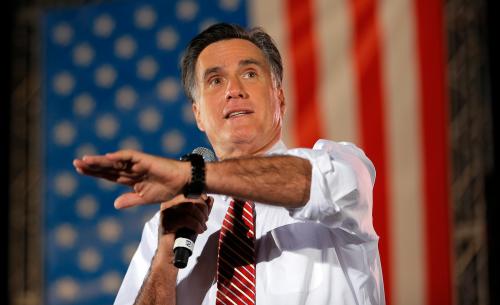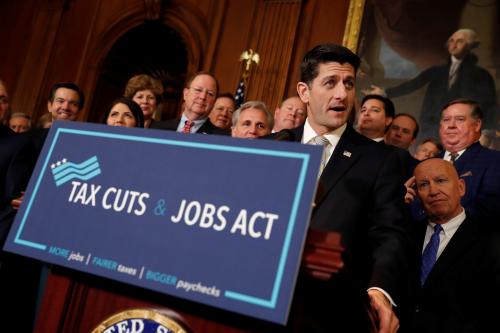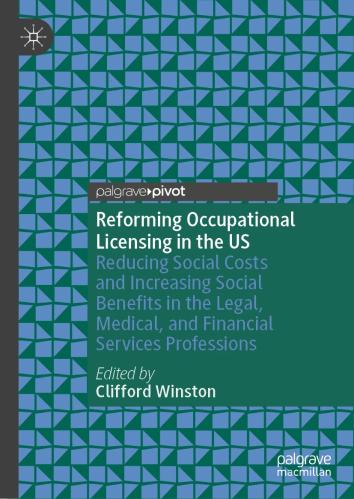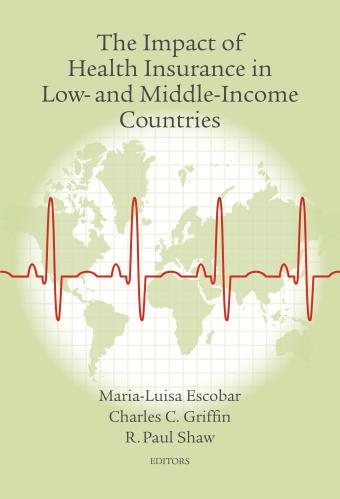The House Ways and Means committee released its long-anticipated tax proposal yesterday, the Tax Cut and Jobs Act (TCJA). The plan offers a sweeping set of changes to taxes on individuals and businesses. Here are nine preliminary takeaways focusing mainly on the individual portions of the bill.
1. This would be a big tax cut, but ill-timed
The tax cuts will raise deficits by about $1.5 trillion over the next decade, consistent with the Congressional budget resolution. Both individuals and businesses, as a whole, would receive tax cuts. But we do not need economic stimulus right now. We are near full employment, so there is little current capacity for higher-than-normal expansion.
From a fiscal perspective, we should be running surpluses when the economy is strong. Instead, we are already running substantial deficits and the tax cuts would add significantly to fiscal shortfalls over the next decade. The proposed tax cuts would add to an already unsustainable long-term fiscal situation.
2. The proposal showers benefits on the wealthiest tax payers, the wrong approach for policy
Several features would provide substantial tax cuts for the very rich. The corporate tax rate would be reduced to 20 percent from 35 percent. Most of this cut would accrue to high-income household because they hold the bulk of the stock. Tax rates on income from pass-through businesses—such as partnerships, S-corps, and sole proprietorships—would fall. This income also skews to the top—about 70 percent of partnership income accrues to the top 1 percent. The threshold for the top personal income tax bracket of 39.6 percent would rise from $470,000 to $1,000,000 (for joint filers), which is an additional tax cut of at least $23,000 for those earning $1 million or more. The alternative minimum tax would be repealed and the estate tax (which applies to only the wealthiest 5,000 decedents each year) would eventually disappear as well.
A big tax cut for the rich is unjustified on fairness or efficiency grounds. The highest earning household—the top 1 percent—have seen dramatic growth in income and wealth relative to other groups over the last 40 years. At the same time, their average tax rate has fallen and this bill would cause it to fall further. Historical and cross-country evidence show no indication that lower tax rates on the rich raise the overall economic growth rate.
3. Many low- and middle- income households will not receive much, if any, benefit from the TCJA, and some will face higher taxes
The TCJA roughly doubles the standard deduction, increases the child tax credit to $1,600, and introduces a new tax credit for taxpayers and non-child dependents, but it also eliminates personal exemptions and raises the lowest marginal income tax rate to 12 percent. Together, these actions produce a mixture of effects on low- and middle-income households. I expect that some will see tax increases, some will have their tax situation unchanged, and some will see tax cuts.
4. The proposal leaves $1.5 trillion in tax cuts unpaid for
The bill contains about $5.8 trillion in gross tax cuts and $4.3 trillion in revenue raisers. Chief among the latter are the elimination of the itemized deduction for state and local income and sales taxes, a limit of $10,000 for the itemized deduction on property taxes, the elimination of personal and dependent exemptions, curtailment of business interest deductions, as well as a new 20 percent excise tax on payments from U.S.-based multinational firms to their foreign affiliates. Finding a coalition to support all of these base-broadeners will be a key challenge for Republican leaders.
5. Tax cuts have to be financed, which likely exacerbates the distributional effects
Over the long run, tax cuts must be offset by some combination of increases in other taxes and cuts in spending. This constraint is particularly salient now, as the government is already on an unsustainable long-term fiscal path. While most taxpayers will receive a direct benefit in the near-term from the proposed tax cut, consideration of the eventual financing can dramatically alter that result. Under plausible financing scenarios, the vast majority of households, especially low- and middle-income households, would be worse off (i.e., would have lower net income) under the tax proposal plus the financing, than under the status quo. The plausible regressivity of financing is highlighted by the Trump Administration’s budget and the recent Congressional budget resolution, which called for deep cuts in entitlements and the social safety net.
6. The proposal would significantly curtail the value of the mortgage interest deduction—and it’s about time
The mortgage interest deduction will be squeezed from a number of directions. The increase in the standard deduction, the elimination of other itemized deductions, and the reduction in the cap on deductible interest (from loan principal of $1 million to $500,000) will reduce the share of households who itemize—and thus who can take the deduction—from 21 percent to less than 4 percent. The reduction in tax rates will further reduce the value of the deduction. (For many of the same reasons, the incentive to make charitable contributions would also decline.) The significant reduction in the value of the mortgage interest deduction is an appropriate direction for tax policy. The deduction does not raise homeownership rates and it causes a number of problems.
7. Eliminating the state and local income or sales tax deduction and limiting the property tax deductions will be more regressive than it looks
It’s often argued—correctly—that more of the benefits of these tax deductions go to upper-income Americans in higher-tax states. But that’s not the whole story. Repealing it would make it more politically difficult for cash-strapped states and localities to provide vital services such as education, healthcare, and income support because the after-tax cost of paying state and local taxes will increase for residents who used to itemize. To make up lost revenue, states may need to increase their taxes—which tend to be more regressive than federal taxes—and thus push more costs on lower- and middle-income families or cut spending programs that typically benefit low- and middle-income families. This problem will be made worse if Republicans make substantial cuts to Medicaid and other social services, as outlined in their most recent budget proposal.
8. Public opinion does not favor tax cuts for the rich or for corporations
In a recent Pew Research Center survey, 52 percent of respondents said that taxes for large businesses and corporations should be increased. Similarly, 43 percent of respondents said that taxes should be raised on households with income greater than $250,000. Both of these shares are much larger than the 24 percent of respondents in either case who indicated that taxes on these groups should be lowered. The proposal pushes against this tide of public opinion.
9. There are some sleepers in the bill
Several provisions that have small revenue implications may nonetheless ignite controversy. The proposal would make it legal to contribute to a 529 Education Saving Plan on behalf of an unborn child (which is described as “a member of the species homo sapiens, at any stage of development, who is carried in the womb). Under new alimony agreements, payments would no longer be deductible to the payer or taxable to the recipient. Churches would be allowed to make political statements. Tax credits for adoption and for disabled and retired people would be eliminated. Former students won’t be able to deduct student loan interest. Many of the new provisions would not be indexed for inflation, and the way other tax provisions are indexed for inflation would change. These, and many other provisions, will be scrutinized heavily over the coming days and weeks to determine their ultimate impact and whether there might be unintended consequences.
The Brookings Institution is committed to quality, independence, and impact.
We are supported by a diverse array of funders. In line with our values and policies, each Brookings publication represents the sole views of its author(s).










Commentary
9 Things to know about the House GOP tax plan
November 3, 2017